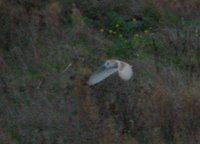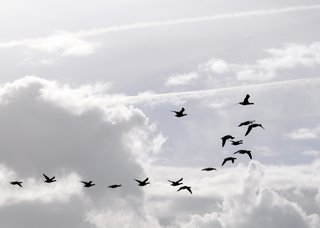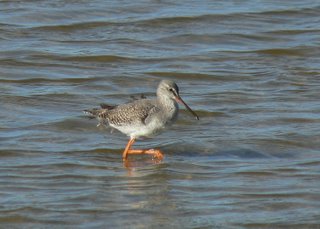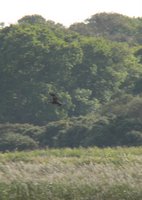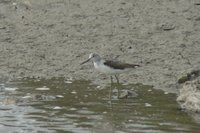Yesterday I wrote:
"OK, so the wind is E / SE. Perfect. Tomorrow (Saturday) morning is clear, I have permission from J to go birding (!), and I have the car. The weather forecast is good. Surely nothing can stop me now?"
Except, I realised as I opened the curtains at 6.30am this morning, a thick mist and awful visibility - which is a shame, because that's exactly what I got. Still, we patch birders are a hardy breed, so with hope in my heart I headed off on my marathon morning, planning to visit Leam Valley, Ufton Fields and then Napton Reservoir if time allowed.

Unfortunately Leam Valley did little to lift my spirits. The mist lingered throughout my visit, and there were no spectacular finds to be had. There were certainly an unusually high number of Long-tailed Tits though, a theme that was to continue at Ufton and Napton, and also a goodly number of Goldfinch, along with a couple of old favourites, a male Bullfinch and a Grey Wagtail.
I pressed on to Ufton, but found little to lighten the mood on this grey morning. The only new birds for the day were a Jay, a few Goldcrest and a Coal Tit. So far I had been out for three hours, found just 25 species, and precious little sign of autumn.
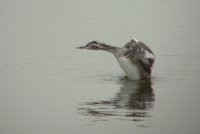
It was Napton which restored my spirits and refreshed my soul. After an unpromising walk round the north water (the smaller of the two areas of open water), I turned back to view the south water and there before me was a female Goosander. I swear it was at that very moment that the mist lifted and the sun came out. Goosanders are wonderful ducks, sleek and bright and a real winter pleasure. They breed near fast-flowing rivers in the north, and then head south to spend

the winter somewhere a little warmer. They are common at nearby Draycote Reservoir, but on my patch I've only previously found them on one occasion at Leam Valley.
The Goosander on its own was sufficient to make a good morning, but it got better still. I quickly located a female Wigeon, again only my second on patch, and the first for two years. A big flock of Starlings was great to watch, but even more so when a late-migrating Hobby flew through the middle of the flock, heading resolutely south.
There were other good birds - eight Skylarks caused a commotion nearby, four Reed Buntings showed well, and three Bullfinch played in the ever-strengthening sun. The photos above are of some of the more obliging birds - a Black-headed Gull, a singing Robin (perhaps freshly arrived from Germany, who knows?), and a juvenile Great Crested Grebe, still quite young in its stripey plumage.
But for me, the highlight of the whole day was the sight and sound of nine Redwing flying overhead. These quintessential autumn migrants are newly arrived, perhaps from Scandinavia or even further north. They are neat and handsome thrushs with red underwings and a distinctive pale stripe over the eye. They can be seen throughout the winter, either feeding on berries or flying overhead, sometimes in huge flocks. Look out for them and enjoy them while you can - they were a thrill for me today, and will continue to be through the long winter months ahead.
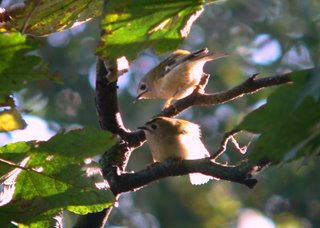 It's been a beautiful day, and I had a lovely morning at Napton. The female Goosander is still there, along with many of the usual residents - a large number of Coots (c. 85), a few Tufted Ducks and plenty of Black-headed Gulls. Other birds of note included a couple of Grey Wagtail, a Cettis Warbler (heard only), a plentiful supply of thrushes included Redwing and a Song Thrush, and a field seemingly full of Sky Larks - perhaps only 6 or 8 though.
It's been a beautiful day, and I had a lovely morning at Napton. The female Goosander is still there, along with many of the usual residents - a large number of Coots (c. 85), a few Tufted Ducks and plenty of Black-headed Gulls. Other birds of note included a couple of Grey Wagtail, a Cettis Warbler (heard only), a plentiful supply of thrushes included Redwing and a Song Thrush, and a field seemingly full of Sky Larks - perhaps only 6 or 8 though. I drove next to Brandon (past a field containing perhaps 120+ Lapwing) and was pleased to find a few nice birds, albeit again nothing exceptional - plenty of Lapwing, more than 20 Common Snipe, a female Pintail and plenty of Goldcrest, including a rare opportunity to photograph a pair.
I drove next to Brandon (past a field containing perhaps 120+ Lapwing) and was pleased to find a few nice birds, albeit again nothing exceptional - plenty of Lapwing, more than 20 Common Snipe, a female Pintail and plenty of Goldcrest, including a rare opportunity to photograph a pair.
